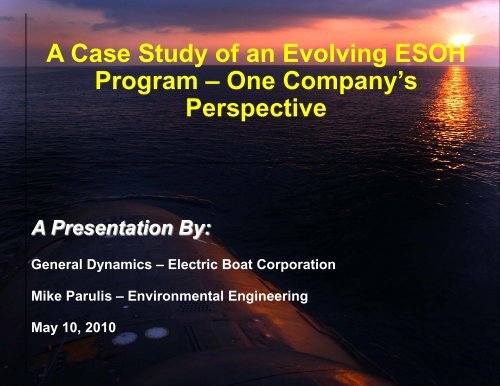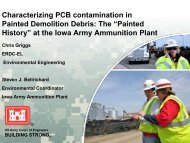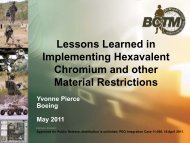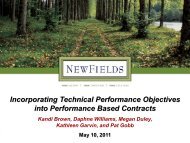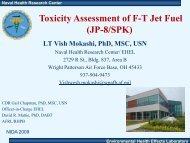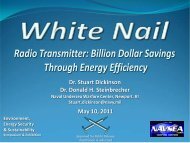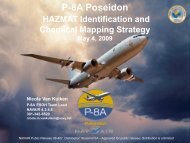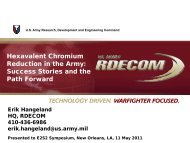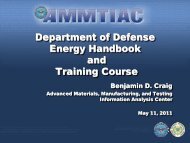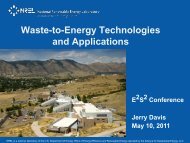A Case Study of an Evolving ESOH Program â One ... - E2S2
A Case Study of an Evolving ESOH Program â One ... - E2S2
A Case Study of an Evolving ESOH Program â One ... - E2S2
You also want an ePaper? Increase the reach of your titles
YUMPU automatically turns print PDFs into web optimized ePapers that Google loves.
A <strong>Case</strong> <strong>Study</strong> <strong>of</strong> <strong>an</strong> <strong>Evolving</strong> <strong>ESOH</strong><br />
<strong>Program</strong> – <strong>One</strong> Comp<strong>an</strong>y’s<br />
Perspective<br />
A Presentation By:<br />
General Dynamics – Electric Boat Corporation<br />
Mike Parulis – Environmental Engineering<br />
May 10, 2010
Presentation Agenda<br />
• Objective<br />
• Background Information<br />
• An <strong>Evolving</strong> <strong>ESOH</strong> <strong>Program</strong><br />
• What…How…Who<br />
• Examples<br />
• Achievements<br />
• Summary<br />
2
Presentation Objectives<br />
• Illustrate the evolution <strong>of</strong> the environment, safety &<br />
occupational health (<strong>ESOH</strong>) discipline <strong>an</strong>d its place within<br />
Electric Boat.<br />
• Emphasize that <strong>ESOH</strong> is part <strong>of</strong> <strong>an</strong> integrated systems<br />
approach, involving <strong>ESOH</strong> engineers, as well as shipyard,<br />
design <strong>an</strong>d engineering org<strong>an</strong>izations.<br />
• Demonstrate, through a few examples, that <strong>E2S2</strong> goals<br />
succeed within <strong>an</strong> integrated <strong>ESOH</strong> <strong>Program</strong>.<br />
3
Laws &<br />
Regulations<br />
Background Information<br />
Laws & Regulations Flowdown<br />
CAA<br />
CWA<br />
APPS UNDS<br />
OSHA<br />
NEPA<br />
‣ Ship Specifications<br />
‣ Contract Requirements<br />
‣ <strong>Program</strong>-specific HSI<br />
<strong>an</strong>d <strong>ESOH</strong> Pl<strong>an</strong>s<br />
4
Background Information<br />
The Life Cycle Approach<br />
M<strong>an</strong>ufacturing<br />
<strong>an</strong>d<br />
Construction<br />
Operations<br />
DESIGN/BUILD/SUSTAIN<br />
Mainten<strong>an</strong>ce <strong>an</strong>d<br />
Overhaul<br />
Ship <strong>an</strong>d System<br />
Recycling/Disposal<br />
5
Background Information - HSI Domains<br />
Equips warfighters<br />
with the needed<br />
knowledge,<br />
skills & abilities<br />
Ensures that all<br />
aspects <strong>of</strong> the<br />
living <strong>an</strong>d working<br />
spaces are<br />
designed with the<br />
warfighter in mind<br />
Training<br />
Addresses all aspects<br />
<strong>of</strong> defining requirements<br />
for personnel as well as<br />
obtaining <strong>an</strong>d retaining<br />
those individuals<br />
Habitability<br />
Personnel<br />
M<strong>an</strong>power<br />
Personnel<br />
Survivability<br />
Provides that the warfighter<br />
will have all personal<br />
protection needed<br />
Environment<br />
System<br />
Safety<br />
Occupational<br />
Health<br />
Hum<strong>an</strong><br />
Factors<br />
Ensures that all<br />
aspects <strong>of</strong> the<br />
system are<br />
designed with<br />
full consideration<br />
<strong>of</strong> the inherent<br />
capabilities <strong>an</strong>d<br />
limitations <strong>of</strong> the<br />
warfighter<br />
Design features<br />
that minimize<br />
the risks <strong>of</strong> illness,<br />
disability or death,<br />
<strong>an</strong>d enh<strong>an</strong>ce job<br />
perform<strong>an</strong>ce <strong>an</strong>d<br />
productivity <strong>of</strong> the<br />
personnel that<br />
operate, maintain or<br />
support the system<br />
6
An <strong>Evolving</strong> <strong>ESOH</strong> <strong>Program</strong> –<br />
Overall <strong>Program</strong> Level Focus<br />
1990 2000 2010<br />
MIL-STD-882B / C<br />
Environmental<br />
Compli<strong>an</strong>ce<br />
System Safety<br />
Environmental<br />
Implementation Pl<strong>an</strong><br />
No Unique Ship Specification<br />
System Safety<br />
Description Document<br />
Ship Specification 077<br />
“System Safety”<br />
MIL-STD-882D<br />
<strong>ESOH</strong><br />
<br />
MIL-STD-882D<br />
w/ch<strong>an</strong>ge 1<br />
<br />
<strong>ESOH</strong> <strong>Program</strong> Pl<strong>an</strong><br />
VIRGINIA Class<br />
Block I & II<br />
VIRGINIA CLASS<br />
VIRGINIA Class<br />
Block III<br />
7
An <strong>Evolving</strong> <strong>ESOH</strong> <strong>Program</strong> –<br />
Overall <strong>Program</strong> Level Focus<br />
1990 2000 2010<br />
MIL-STD-882B / C<br />
MIL-STD-882D<br />
<br />
MIL-STD-882D<br />
w/ch<strong>an</strong>ge 1<br />
<br />
<strong>ESOH</strong><br />
<strong>ESOH</strong> <strong>Program</strong> Pl<strong>an</strong><br />
Ship Specification 9310-3<br />
“Environment, Safety <strong>an</strong>d<br />
Occupational Health (<strong>ESOH</strong>)”<br />
SSGN CONVERSION<br />
8
An <strong>Evolving</strong> <strong>ESOH</strong> <strong>Program</strong> –<br />
Overall <strong>Program</strong> Level Focus<br />
1990 2000 2010<br />
MIL-STD-882B / C<br />
HSI<br />
MIL-STD-882D<br />
Hum<strong>an</strong> Systems<br />
Integration Pl<strong>an</strong><br />
<br />
MIL-STD-882D<br />
w/ch<strong>an</strong>ge 1<br />
<br />
<strong>ESOH</strong> Engineering Pl<strong>an</strong><br />
Ship Specification 077<br />
“Environment, Safety <strong>an</strong>d<br />
Occupational Health (<strong>ESOH</strong>)”<br />
<strong>ESOH</strong><br />
Ship Specification 088<br />
“Hum<strong>an</strong> Engineering”<br />
[‘…a domain <strong>of</strong> Hum<strong>an</strong><br />
Systems Integration…”]<br />
OHIO REPLACEMENT<br />
CLASS<br />
9
An <strong>Evolving</strong> <strong>ESOH</strong> <strong>Program</strong> –<br />
Org<strong>an</strong>izational Structure<br />
1990 2000 2010<br />
VIRGINIA Class<br />
Block I & II<br />
SSGN Conversion<br />
VIRGINIA Class<br />
Block III<br />
OHIO<br />
Replacement<br />
Class<br />
System Safety Engineering<br />
D495 – TRIDENT Pl<strong>an</strong>ning<br />
D428 – Electrical System Design<br />
D411 – Life Cycle Engineering<br />
Life Cycle<br />
Engineering<br />
> Hum<strong>an</strong> System<br />
Engineering <strong>Program</strong>s<br />
> RMA & <strong>ESOH</strong><br />
X<br />
X<br />
Hum<strong>an</strong> Factors Engineering<br />
D427 – Power & Auxiliary System<br />
Environmental<br />
Engineering<br />
D411 – Life Cycle Engineering<br />
D470 - Life Cycle Support<br />
10
<strong>ESOH</strong> Engineering<br />
<strong>ESOH</strong> Engineers are<br />
integrated into<br />
Design/Build/Sustain<br />
Teams to provide the<br />
<strong>ESOH</strong> perspective to help<br />
design out potential<br />
safety hazards <strong>an</strong>d<br />
environmental impacts<br />
early in the design<br />
process.<br />
Opportunities Await in the OHIO Replacement <strong>Program</strong> !<br />
11
Here’s What <strong>ESOH</strong> Engineering Does…<br />
Minimize / Eliminate Safety Hazards &<br />
Environmental Impacts:<br />
‣ Carcinogens (lead, cadmium, beryllium, Cr 6+ )<br />
‣ Ozone Depleting Subst<strong>an</strong>ces -ODSs-<br />
(freon, 1,1,1-trichloroeth<strong>an</strong>e)<br />
‣ Volatile Org<strong>an</strong>ic Compounds -VOCs-<br />
(toluene, MEK, trichloroethylene)<br />
‣ Greenhouse gases-GHGs-(HFCs)<br />
‣ Toxic <strong>of</strong>f-gassing products<br />
‣ Slips/trips/falls<br />
‣ Unguarded rotating machinery<br />
‣ Mech<strong>an</strong>ical/electrical/acoustic shock<br />
The Earlier in the Design that Hazards are Identified, the<br />
Easier it is to Implement Ch<strong>an</strong>ge in the Design<br />
12
Here’s How We Make It Happen...<br />
Participate In Design<br />
Reviews <strong>an</strong>d Product<br />
Development<br />
Perform Hazard Analyses<br />
in Accord<strong>an</strong>ce With<br />
MIL-STD-882<br />
‣ Construction & Vendor Dwgs<br />
‣ System Diagrams<br />
‣ Test Procedures<br />
‣ St<strong>an</strong>dard Parts Library<br />
‣ Alteration Work Packages<br />
‣ Tech M<strong>an</strong>uals & Ship System M<strong>an</strong>uals<br />
This Process Supports All Submarine Classes <strong>an</strong>d<br />
Development Projects<br />
13
Here’s How We Make It Happen...<br />
<strong>ESOH</strong> Filter Includes:<br />
‣ Ship Spec Requirements<br />
‣ NAVSEA Lists <strong>of</strong> Hazardous Materials<br />
‣ Submarine Atmosphere Control M<strong>an</strong>ual (ACM) Requirements<br />
‣ Electric Boat SP 7-20 (Chemical Risk Reduction)<br />
‣ DoD Emerging Contamin<strong>an</strong>ts List<br />
‣ Hum<strong>an</strong> Engineering Design St<strong>an</strong>dard Practice<br />
‣ Naval Ships’ Technical M<strong>an</strong>uals<br />
Identify <strong>ESOH</strong> Hazards <strong>an</strong>d<br />
Mitigating Actions<br />
‣ Environmental Impacts<br />
‣ Safety Hazards<br />
14
Here’s How We Make It Happen...<br />
Implement Mitigating Ch<strong>an</strong>ges<br />
to Designs <strong>an</strong>d Procedures<br />
Document Results in<br />
Reports <strong>an</strong>d Databases<br />
Eliminate <strong>ESOH</strong> Hazards<br />
‣ Unsafe Conditions<br />
‣ Toxic Exposures<br />
‣ HazMat Disposal<br />
15
Example #1: Procedural Improvement<br />
PROBLEM<br />
Existing Tech M<strong>an</strong>ual (TM) had<br />
No Beryllium Warning<br />
VIRGINIA & SSGN hazmat<br />
DoD “Emerging Contamin<strong>an</strong>t”<br />
Carcinogen<br />
SOLUTION<br />
During TM Revision, Added<br />
“WARNING” Statements at Each<br />
Step Involving Work on<br />
Beryllium Piece Parts<br />
16
Example #2: VIRGINIA Class<br />
Plastics Waste Stowage<br />
The Act to Prevent Pollution<br />
from Ships (APPS) Prohibits<br />
Navy Submarines from<br />
Disposing Plastics at Sea<br />
After December 31, 2008.<br />
Stowage <strong>of</strong> Plastics Waste<br />
Creates a Potential Fire<br />
Safety Risk Due to the<br />
Concentration <strong>of</strong> the<br />
Plastics Waste Becoming<br />
Fire Sustaining Fuel.<br />
17
Example #2: VIRGINIA Class<br />
Plastics Waste Stowage (Cont’d)<br />
Testing was Performed to Assess<br />
Fire Characteristics <strong>of</strong> Burning Bags<br />
Filled With Plastics Waste<br />
A Fire Risk Assessment per MIL-<br />
STD-882 was Performed<br />
‣No additional design ch<strong>an</strong>ges were<br />
recommended in the stowage<br />
arr<strong>an</strong>gement in the environmental<br />
space<br />
‣The risk was considered acceptable<br />
by the Fire Fighting System<br />
Design/Build Team <strong>an</strong>d the NAVSEA<br />
<strong>Program</strong> Office.<br />
18
Example #3: VIRGINIA Payload Tube (VPT)<br />
Multiple All-Up-Round C<strong>an</strong>ister (MAC)<br />
Center Access Ladder<br />
Confined Space Safety Issues (Limited Access to Equipment<br />
<strong>an</strong>d No Outside Ventilation) Documented in the VPT<br />
Preliminary Hazard Analysis (PHA).<br />
No Access to<br />
the Payload<br />
Tubes From<br />
Inside the<br />
Ship Like<br />
SSGN Class<br />
19
Example #3: VPT MAC<br />
Center Access Ladder (Cont’d)<br />
Demonstrating Accessibility to<br />
Vital Equipment (Full Scale<br />
Wooden Mock-up)<br />
Hazard Mitigation Includes:<br />
Providing Continuous Forced Air<br />
Ventilation to the VPT Through a<br />
Custom-built Center Cell Ladder<br />
20
Example #4: Maintaining Approved<br />
Consumables Lists<br />
Lists <strong>of</strong> Approved Consumables Were<br />
Developed Early in the VIRGINIA Class<br />
<strong>Program</strong><br />
Those Lists are Kept<br />
Current <strong>an</strong>d are Viewable<br />
on the EB Intr<strong>an</strong>et<br />
21
<strong>ESOH</strong> <strong>Program</strong> Achievements<br />
A Successful Team Approach has resulted in:<br />
‣ 1995-1997 Environmental Security Awards - VIRGINIA Class<br />
Excellence in Pollution Prevention by a Weapon System<br />
Acquisition <strong>Program</strong> (NAVSEA/CNO/DoD/DON)<br />
‣ 1998 EPA Stratospheric Ozone Protection Award to VIRGINIA<br />
Class <strong>Program</strong><br />
‣ 2006 Dept <strong>of</strong> Navy Special Recognition for Excellence -<br />
awarded to SSGN <strong>ESOH</strong> Integrated Product Team<br />
22
<strong>ESOH</strong> Success Recognized<br />
Special Recognition by the Navy for<br />
Excellence in Safety in the Field <strong>of</strong> Acquisition<br />
“The program emphasizes the integration <strong>of</strong> safety <strong>an</strong>d<br />
environmental engineers into the design/build teams to add<br />
the element <strong>of</strong> objectivity into hazard <strong>an</strong>alyses. This team<br />
exemplifies the benefits <strong>of</strong> the early integration <strong>of</strong> safety<br />
concerns into the acquisition process.”<br />
Hon. Donald C. Winter, Secretary <strong>of</strong> the Navy<br />
September 2006<br />
23
Summary<br />
• Performed <strong>ESOH</strong> tasks in a variety <strong>of</strong> successful<br />
projects <strong>an</strong>d programs<br />
• Successfully integrated environmental considerations<br />
into the System Safety approach described in MIL-STD-<br />
882 (DoD St<strong>an</strong>dard Practice for System Safety)<br />
• Continue to interface with Shipyard Safety, Fire Dept.,<br />
Industrial Hygiene, vendors, Environmental Resources<br />
M<strong>an</strong>agement, <strong>an</strong>d Design/Build/Sustain teams in <strong>ESOH</strong><br />
tasks<br />
<strong>E2S2</strong> Goals Succeed With <strong>an</strong><br />
Integrated <strong>ESOH</strong> Approach<br />
24


